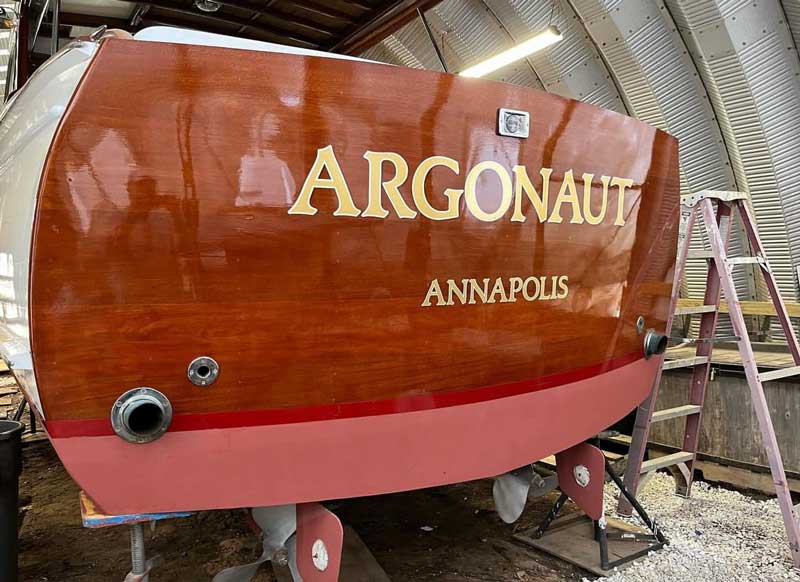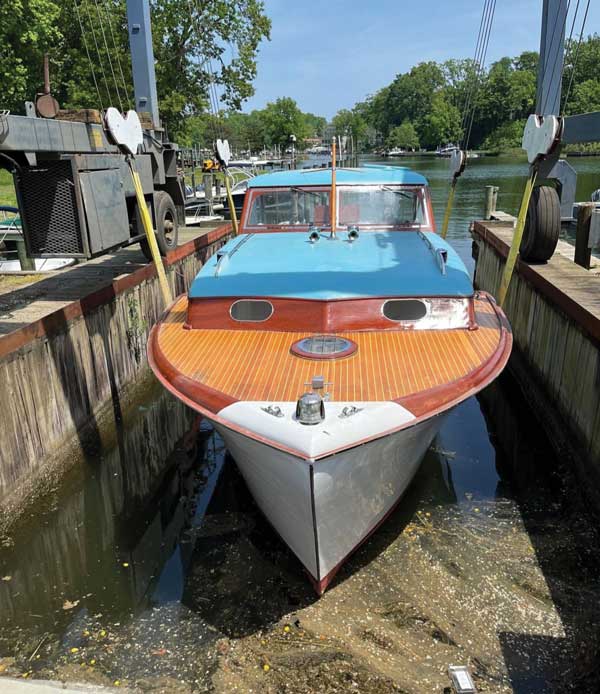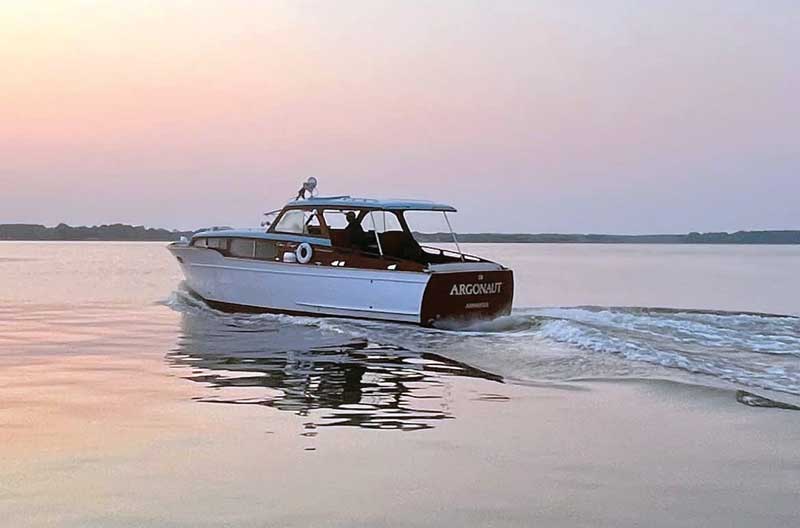The name Chris-Craft has long been associated with beautiful, classic wooden motorboats, gleaming with chromed hardware and glistening varnished mahogany, driven by powerful engines and with lines pleasing to the eye in so many ways. The round, plump-looking hulls of the 1950s seem at times to epitomize this style. They were comfortable, roomy, and with a little throttle, knew how to get out of their own way. In today’s world, they require a lot of work and resources to maintain and to restore, but when kept in Bristol condition, they win awards and keep winning them, year after year.
Without question, it takes determination to follow through with a project such as restoring a wooden boat of that vintage. When you begin a restoration like that, the deeper you get into it, the more rotten wood that you pull away, the deeper yet you discover that you must go. And the deeper into your pockets you must also dig, you discover. My grandfather, who was a boat builder, once told me that before beginning a restoration job, it was necessary to first rip out everything bad before you can take stock of what you have left and begin reconstructing.
So, we have to offer congratulations to Hank Reiser and Jason Corsini at Marine Services, LLC at Pocohontas Marina in Edgewater, MD. Their restored 1951 34-foot Chris-Craft Commander Argonaut won the platinum medal, and their restored 1951 Chris-Craft Sportsman Old and In the Way won a silver, at the Antique and Classic Boat Festival this past June at the Chesapeake Bay Maritime Museum in St. Michaels. Owned by Terry Dunn, Argonaut took a Gold medal this year, 2024, and a Platinum medal at the 2023 Festival, as well as the Chris-Craft award. Marine Services LLC specializes in boat restoration.
The boat, when originally launched, was powered by Chris-Craft engines. However, when Dunn acquired the boat, it had been repowered with General Motors small-block V-8 engines that were not in good condition. Hank and his team rebuilt the boat, including replacing the transom, repairing the woodwork, and upgrading various systems. The award-winning boat is currently being used regularly by its owner.

According to Hank, “Originally the boat was shipped from the Caruthersville, MD, plant with a pair of Chris-Craft MLs, and those are 145-hp each with 2:1 reduction. When Dunn acquired the boat, it had been repowered at some point in the early 70s with some General Motors small block V-8s that were not serviceable any longer, nor had they been well installed. Most of the framing was out of the bottom of the boat to fit them low enough, and then boxes were put on top of the cockpit sole, so it was just a horrifying arrangement. I’m surprised the engines didn’t fall through the bottom of the boat. Terry had purchased the boat sight-unseen down in Tennessee somewhere, and he went to every marina he could find; no one would touch the boat. Then he came to us.”
Hank and Jason were going to do a proper restoration, and they were going to do it right from the start. They ordered two Chris-Craft MLs built at LaPointe Marine in Minnesota and had them shipped out to Edgewater where they installed them into the boat, but there was a catch: the engine stringers had been cut up, so Jason, who specializes in woodworking, had to do a lot of forensic work to ‘put things back the way they belonged’ and get the MLs back in the right position. As Hank explains, “The ML is a 1951 block, from the same year as the boat. Mitch La Pointe at La Pointe Marine does tons of engine rebuilds and restorations. So, after LaPointe was done with them, they were zero-hour engines when we got them, but they were 1951 blocks. He uses all Federal-Mogul parts the same as Chris-Craft used.”
“Terry Dunn bought the boat and contracted us to put the boat back together, basically. He purchased the boat in Tennessee after he saw an ad for it in a boneyard boats magazine, bought it, and had it trucked up here. The transom had been cut off and plywood was drywall-screwed onto it. So that was my original job, just to rebuild the transom. Of course, there were also the planks back aft going to the transom. They were all rotted back two or three or four feet. Oh, we had a lot of work to do there. Kind of like Huck Finn painting the fence.”

Everything was done properly, however. For example, the transom replacement was with solid stock mahogany planking, not plywood, and the hull is double-planked.
After the transom, the team worked their way forward, replacing decks, working down the sides, rebuilding the entire cockpit, re-caulking the hull, and ended up rebuilding the entire engine room because of the damage that had been done installing the old V-8 engines. “There was some damage to the foredeck, which led to replacing the entire decks on the whole boat. We had redone the cockpit and then we moved to the foredeck and all the side decks with all new sub-decking and repairs as needed.”
After that, the boat was moved into a shed, where the coach roof, pilot house, and cabin house roofs were stripped of paint and the original canvas cloth. It was replaced with Xynole, a polyester cloth similar to Dynel, and then it was faired and bedded in epoxy.
“After 65 or 70 years, there were a lot of loose and dead wires,” Hank says. “We tore every wire out of the thing. We had the instruments rebuilt at a shop in Minnesota, and we also rewired the helm and all the DC distribution, the AC distribution, the battery cables, you name it. Then we replaced all the plumbing, water, and fuel lines. We installed new fuel tanks, and the owner sourced a beautiful antique head for us. We installed holding tanks (MSDs) because the boat had never had a holding tank at all.” The new fuel tanks are epoxy-coated aluminum, built by Atlantic Coastal in New Jersey. We had the old Monel tanks, but they were full of holes, so we took the dimensions off those tanks and had the new ones made the same size.”

Nearly every piece of bronze hardware was removed and re-chromed to stay true to the original. “The nice thing about this boat being a freshwater boat down in the Tennessee waterways is that it did have most, if not all, of the original hardware onboard,” Hank says. “There wasn’t much to replace or source, so that was a nice thing. Pretty much everything we could access on this boat, we have touched at some point and either replaced, or painted, or sealed.”
Now, Argonaut, with her somewhat hard chine hull shape, will make 12 knots at 1500 rpm, a respectable cruising speed, Hank says. “Wide open throttle on those engines is 3000, and she should run at 27 miles per hour, but I don’t run her that hard just because I don’t want to blow anything up,” he said with a laugh. “But seriously, we’ve gotten 21 statute miles per hour out of her, but she really is happiest at 12 knots at 1500. She runs really nice at that speed.”
“A lot of credit goes to Terry Dunn for finding the boat and then deciding to go through with the restoration. He’s been a dedicated customer and despite a lot of problems that we found in the boat, he has always been eager to move forward. So, a lot of credit goes to him for financing the restoration of Argonaut,” Hank concludes.
By Capt. Michael L. Martel